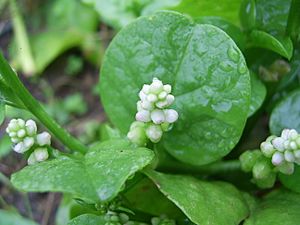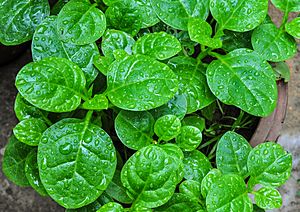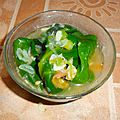Malabar spinach facts for kids
Quick facts for kids Malabar spinach |
|
|---|---|
 |
|
| Scientific classification | |
| Genus: |
Basella
|
| Species: |
alba
|
| Synonyms | |
|
|
Basella alba is a cool plant that grows like a vine. It's also known as Malabar spinach, vine spinach, Ceylon spinach, or Indian spinach. This plant is special because it grows back every year, making it a perennial plant. It belongs to the Basellaceae family.
You can find Malabar spinach in warm, tropical places like Asia and Africa. It's originally from the Indian subcontinent, Southeast Asia, and New Guinea. But it has also spread to many other countries, including China, Brazil, the Philippines, and the Caribbean. People often grow it to eat its leaves, which are a popular leaf vegetable.
Contents
What Does Malabar Spinach Look Like?
Malabar spinach is a fast-growing vine that can reach up to 10 meters (about 33 feet) long! Its stems are soft, and its leaves are thick and shaped like hearts. These leaves have a mild taste and a slightly slimy texture, which is normal for this plant.
There are two main types of Malabar spinach: green and red. The green type has green stems and green leaves. The red type, called Basella alba 'Rubra', has reddish-purple stems. As the red plant gets older, its leaves might also turn a bit purple, starting from the bottom. If you crush the stem, it usually has a strong smell. You can often find Malabar spinach at Asian grocery stores and farmers' markets.
Where Does Malabar Spinach Grow Best?
This plant loves hot and humid weather with lots of sunshine. It grows best in areas that are not too high up, usually below 500 meters (about 1,640 feet) above sea level. When the conditions are just right, it can grow super fast!
Malabar spinach grows slower when it's cold. If the daytime temperature drops below 10-15°C (about 50-60°F), it won't grow much. Since it comes from the Indian subcontinent, it's a true tropical plant. It prefers temperatures between 21°-32°C (about 70°-90°F). It can even grow well around 37°C (about 100°F), but sometimes it needs a little shade to protect it from too much sun. It also likes soil that drains well and has lots of good stuff for plants, with a pH between 5.5 and 7.0.
| Nutritional value per 100 g (3.5 oz) | |
|---|---|
| Energy | 79 kJ (19 kcal) |
|
3.4 g
|
|
|
0.3 g
|
|
|
Protein
|
1.8 g
|
| Vitamins | Quantity
%DV†
|
| Vitamin A equiv. |
50%
400 μg |
| Thiamine (B1) |
4%
0.05 mg |
| Riboflavin (B2) |
13%
0.155 mg |
| Niacin (B3) |
3%
0.5 mg |
| Vitamin B6 |
18%
0.24 mg |
| Folate (B9) |
35%
140 μg |
| Vitamin C |
123%
102 mg |
| Minerals | Quantity
%DV†
|
| Calcium |
11%
109 mg |
| Iron |
9%
1.2 mg |
| Magnesium |
18%
65 mg |
| Manganese |
35%
0.735 mg |
| Phosphorus |
7%
52 mg |
| Potassium |
17%
510 mg |
| Zinc |
5%
0.43 mg |
| Other constituents | Quantity |
| Water | 93 g |
|
Link to USDA Database entry
|
|
| †Percentages estimated using US recommendations for adults. | |
Why is Malabar Spinach Good for You?
Malabar spinach leaves are very healthy! They are mostly water (93%) and have some carbohydrates and protein. They have very little fat.
If you eat about 100 grams (a little less than half a cup) of these leaves, you get only 19 calories. They are packed with important things your body needs. They are a great source of vitamins A and C, folate, and manganese. They also have good amounts of B vitamins and other important dietary minerals.
How People Use Malabar Spinach
People around the world use Malabar spinach in many different ways. It's a very versatile vegetable!
Cooking with Malabar Spinach Around the World
- In Sri Lanka, people use it to make tasty curries, especially with dal (lentils).
- In the Philippines, the leaves are a main ingredient in a vegetable dish called utan. It's often cooked with sardines, onions, garlic, and parsley, and served over rice.
- In Mangalorean Tuluva cooking, they make a coconut-based sauce called gassi with Malabar spinach. This dish, called Basale gassi, is eaten with rice dumplings. Sometimes, they add tiny prawns, clams, or dried fish to the sauce.
- In Bengali cuisine, it's used in vegetable dishes, often cooked with red pumpkin. It's also used in dishes with fish bones or shrimp.
- In Odia cuisine, they cook it with mustard paste to make 'poi saaga rai'.
- In Andhra Pradesh, a state in India, they make a curry with Malabar spinach and yam.
- In Gujarat, people make crispy fried snacks called "poi na bhajia" by dipping the leaves in a special batter and deep-frying them.
- In Chinese cooking, it's known by many names, including "flowing water vegetable." It's often used in stir-fries and soups.
- In Vietnam, where it's called mồng tơi, it's cooked with shrimp, crab meat, luffa, and jute to make soup.
- In Africa, the cooked shoots, which are a bit slimy, are commonly eaten.
Historically, the red type of Malabar spinach was also used to make red dye in China.
Gallery
-
A seedling of Basella alba. The cotyledons are visible
-
A variety of Basella alba with deep red and purple stems in the Philippines
See also
 In Spanish: Espinaca de Malabar para niños
In Spanish: Espinaca de Malabar para niños






